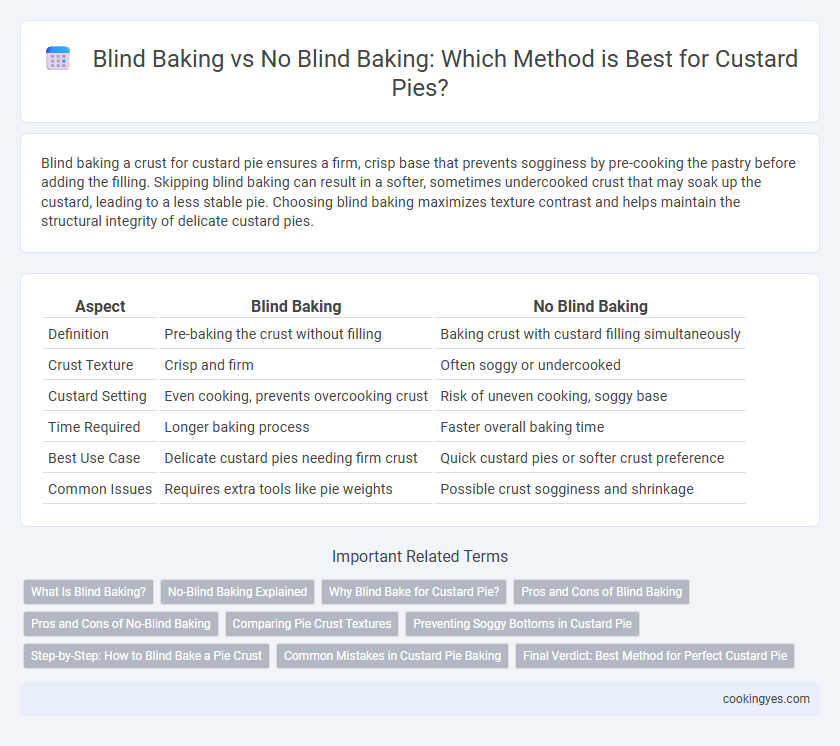Blind baking a crust for custard pie ensures a firm, crisp base that prevents sogginess by pre-cooking the pastry before adding the filling. Skipping blind baking can result in a softer, sometimes undercooked crust that may soak up the custard, leading to a less stable pie. Choosing blind baking maximizes texture contrast and helps maintain the structural integrity of delicate custard pies.
Table of Comparison
| Aspect | Blind Baking | No Blind Baking |
|---|---|---|
| Definition | Pre-baking the crust without filling | Baking crust with custard filling simultaneously |
| Crust Texture | Crisp and firm | Often soggy or undercooked |
| Custard Setting | Even cooking, prevents overcooking crust | Risk of uneven cooking, soggy base |
| Time Required | Longer baking process | Faster overall baking time |
| Best Use Case | Delicate custard pies needing firm crust | Quick custard pies or softer crust preference |
| Common Issues | Requires extra tools like pie weights | Possible crust sogginess and shrinkage |
What Is Blind Baking?
Blind baking is the process of pre-baking a pie crust without the filling to ensure a crisp, fully cooked base, especially important for custard pies. This technique prevents a soggy crust by setting the dough before the wet custard is added. Using pie weights or dried beans during blind baking helps maintain the crust's shape and prevents air bubbles.
No-Blind Baking Explained
No-blind baking a custard pie crust involves pouring the filling into an unbaked crust and baking them together, allowing the custard to set and the crust to bake simultaneously. This method preserves the crust's tender texture and prevents over-drying, which often occurs in blind baking where the crust is baked separately. It is particularly effective for softer custard fillings, ensuring a cohesive, creamy interior without a hard or overly crisp crust.
Why Blind Bake for Custard Pie?
Blind baking ensures the custard pie crust remains crisp and fully cooked, preventing sogginess from the wet filling. The technique involves pre-baking the crust with pie weights to maintain its shape and create a barrier against custard seepage. This process is essential for custard pies because the filling requires gentle baking that won't fully cook the crust if baked together.
Pros and Cons of Blind Baking
Blind baking a custard pie crust prevents sogginess by fully or partially pre-cooking the crust, ensuring a crisp texture and preventing filling moisture from soaking in. However, blind baking adds preparation time and requires weights or pie beads to prevent crust puffing, which can complicate the baking process. Skipping blind baking saves time but risks a soggy bottom and unevenly cooked crust, especially with high-moisture custard fillings.
Pros and Cons of No-Blind Baking
No-blind baking custard pie crust saves time and simplifies preparation by baking the crust and filling simultaneously, reducing steps and potential errors associated with pre-baking. However, this method risks a soggy or undercooked bottom crust due to the filling's moisture content, compromising texture and structural integrity. It allows for a softer crust that some prefer, but careful selection of recipes with thicker fillings is crucial to avoid a weepy or unevenly cooked base.
Comparing Pie Crust Textures
Blind baking custard pie crusts results in a crisp, firm texture that prevents sogginess by setting the crust before filling. Baking the crust without blind baking often yields a softer, sometimes soggy base due to moisture from the custard filling. Choosing blind baking ensures a more structurally sound crust ideal for custard pies with wet fillings.
Preventing Soggy Bottoms in Custard Pie
Blind baking prevents soggy bottoms in custard pies by pre-cooking the crust, ensuring a crisp, sturdy base that resists moisture from the filling. Without blind baking, the crust absorbs custard liquids during baking, leading to a wet, undercooked texture. Baking with pie weights during blind baking maintains crust shape and promotes even heat distribution, crucial for flawless custard pie results.
Step-by-Step: How to Blind Bake a Pie Crust
To blind bake a pie crust for custard pies, preheat the oven to 375degF (190degC) and line the crust with parchment paper or aluminum foil, filling it with pie weights or dried beans to prevent shrinking. Bake the crust for 15-20 minutes until the edges start to turn golden, then carefully remove the weights and lining before baking for an additional 5-10 minutes until the bottom is fully cooked. Blind baking ensures a crisp, firm crust that prevents sogginess when the custard filling is added.
Common Mistakes in Custard Pie Baking
Blind baking the crust prevents soggy bottoms common in custard pies, ensuring a crisp, firm base that holds the delicate filling. Skipping blind baking often leads to a undercooked or watery crust, compromising texture and flavor. Overbaking the crust before adding custard can cause shrinkage and toughness, so precisely timing the blind baking is essential for optimal pie quality.
Final Verdict: Best Method for Perfect Custard Pie
Blind baking the crust ensures a crisp, fully cooked base that prevents sogginess when filled with wet custard, enhancing texture and flavor. Skipping blind baking risks a soggy, undercooked crust due to the custard's moisture content, compromising the pie's structural integrity. For the perfect custard pie, blind baking is the optimal method to achieve a golden, flaky crust and a smooth, creamy filling.
Blind baking vs no-blind baking for custard pie Infographic

 cookingyes.com
cookingyes.com